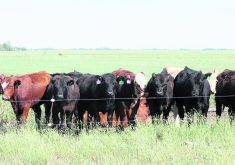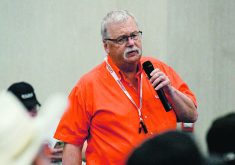Rick Wright of Cattle Consulting doesn’t see any signs that the cattle price gravy train will be slowing any time soon.
“There’s more than just optimism out there. The fundamentals support a pretty good market moving forward,” he said. “Will it be better than 2023? Maybe not, but I think it will be every bit as good as what it was, barring a drought or a black swan event of some type that upsets the market.”
Input costs are up and that will have profit implications if producers aren’t careful, but 2024 is shaping up to be a good market year for cow-calf producers. In fact, Wright said he expects elevated cattle markets to linger for the next two to three years, with strong demand for Manitoba cattle from all regions.
Read Also

Feds propose overhaul of chronic wasting disease control program
Chronic Wasting disease control program getting updated by Canadian Food Inspection Agency with feedback encouraged from producers.
For backgrounders, feedlots and packers — anyone whose business model starts with buying cattle rather than birthing them — things are less rosy. The same high prices will take a bite out of margins farther down the value chain, said Wright.
“I think the big thing is it’s just a matter of who’s taking the margin. The packers were, for a while, and it looks to me like they’re not going to get very much in the next short term. Feedlots have to make a little, but the cow-calf guy has always been running in third place, all the time.
“This last year and moving forward, I think that they’re going to move up in the race a little bit.”
Producers who own their cattle are happy, Wright noted, but farmers across the board will have to monitor the math of their operations if they want to preserve profit.
Even at the cow-calf level, higher prices for replacement and bred animals will change the calculation applied to the purchase of each animal.
“With the high cost of production going up, how much more profitability is it if you take the difference between the interest rate today than what it was two years ago and attach that to a brand new cow at $3,500?” Wright asked.
“What’s your carrying cost on that, just interest alone? You’re going to need another 15 to 20 cents a pound on the calf compared to what you were getting, just to cover that extra interest.”
Wright also told producers to know their cost of production and pay attention to available risk management to protect themselves from the downside.
“If you’re going to be a survivor in this business at the high dollars we’re trading, you need to know how much that cow is costing you, what you need to get out of that cow to be successful,” he said. “Farmer math that we’ve used for years isn’t going to cut it going forward.”
Wright also urged producers to invest time and self-education to polish their marketing game.
The financial realities of the market mean that producers cannot assume their usual time to market is best for the bottom line, nor should they necessarily emulate what their neighbours do.
“You have to really analyze your own herd, your own farming operation and make your decision based on that,” he said.
That might lead to some unconventional market flows. For example, Wright raised the potential of marketing some calves earlier in summer if there’s demand.
Farmers are “afraid that they aren’t going to get what they get in the fall,” he said. “But if you can get a price that looks good and is profitable and makes it work, tie some of them up. Reduce your risk.”
Wright doesn’t expect tight cattle supplies to loosen anytime soon.
Herd size in both the United States and Canada has plummeted, including that of Manitoba, which lost about 84,000 beef head (8.3 per cent) in the two years between July 1, 2021, and July 1, 2023.
In mid-summer 2023, the U.S. reported its beef herd had shrunk to its lowest in 52 years, while the Canadian herd hit its lowest number since 2015. Projections for 2024 have the Canadian beef cow herd shrinking further by 3.7 per cent.
Canadian heifers are not being retained in big numbers, producers heard in Austin, Man., Jan. 10. Canfax reported significant jumps in heifer placements at Canadian feedlots.
“We’re going to see a small contraction again,” Wright said. “Whether we can rebuild or not is going to be the million-dollar question. Will we get back to the numbers that we had in 2016? I don’t think so. The bigger will get bigger. A lot of the small guys will walk out.”
There will also be a lag between the end of herd contraction and volume growth in the feeder market, he noted.
Once heifers start being held back, they will disappear from the feed pens.
“That’s going to short the feeder market again for another two to three years.”
















